From the other side of the horizon
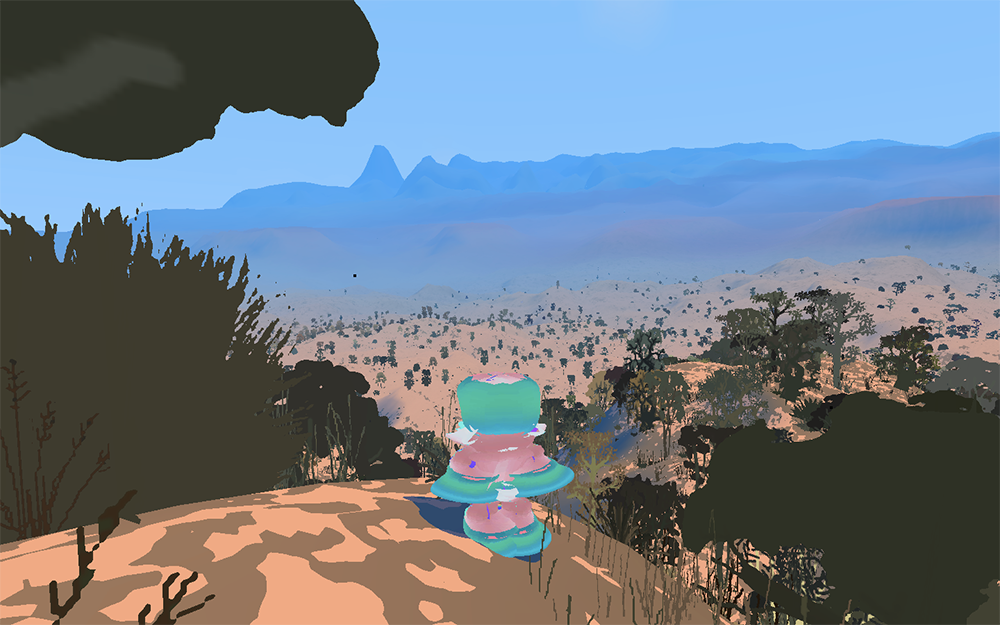
28 August, 2020
From my apartment window, the neat rows of terracotta roofs snake away from me towards the city skyline. The horizon is a jumble of old brick and new glass, with toothpick cranes dotted about, slowly replacing the brick with the glass.
If I take a step back and squat down, the succulent plant on the windowsill is eye level with the city. When I squint, the world outside becomes a two-dimensional backdrop for my plant skyscraper, a new bulbous green landmark for Sydney.
^~^~^~^~^~^~^
Everything I see outside feels closer than before and everything I don’t see has stopped existing. It’s August 2020 and I’m too big for my apartment, which is now equal parts burrow and bell jar.
With nothing to separate the days from each other, all conversations, YouTube binges, meals, and naps happen on top of one another in the blink of months.
Distances stretch longer while geographies become closer. The world outside takes on an abstract scale that shifts and shimmers beyond my gaze. I begin to forget that the horizon used to be something farther away.
^~^~^~^~^~^~^
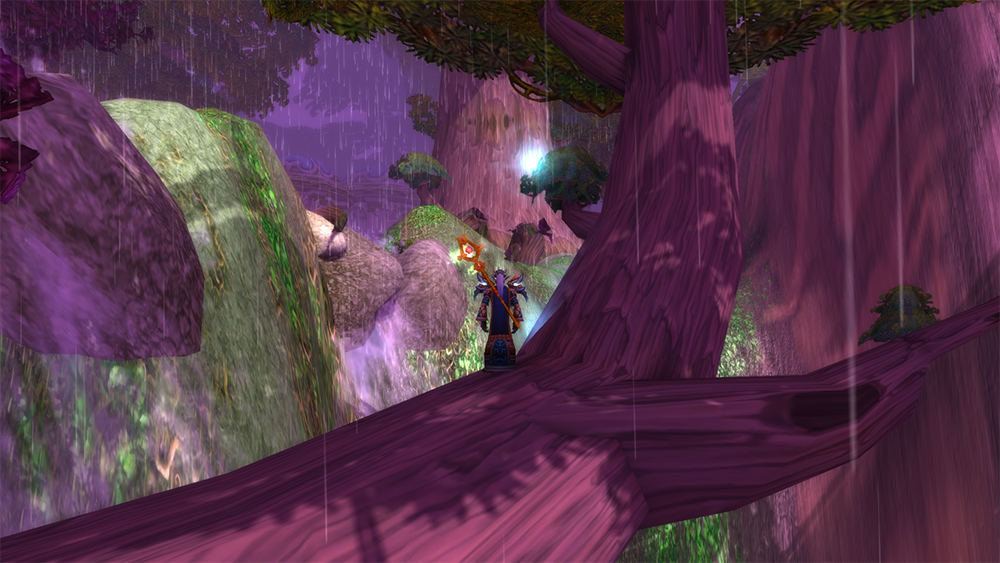
Blizzard Entertainment, World of Warcraft Classic
screenshot (2020)
Emma sometimes sets up a private video stream so I can watch her play World of Warcraft (even though we live on the same street).
She takes me on tours of primordial rainforests, rolling foothills, infinite shores, steep tundra, acid green lakes, ruinous deserts, crystal outcrops, arid canyons, serene plateaus, wastelands and sanctuaries. Instead of killing monsters, Emma rotates the camera view so we can look at the curling red and golden vines in Eversong Woods, and marvel at the hazy dusk lighting design in Elwynn Forest.
I’m not the only one craving a wide horizon—it’s become very popular to explore the open worlds of video games. To simulate the feeling that there’s more beyond the vanishing point if you just keep walking.
Emma’s voice crackles over the mic into my ears: This is really just a collecting things game. The quests send you to get items as a device to encourage exploration. Totally phenomenal.
^~^~^~^~^~^~^
Someone sends me a link to an article about the therapeutic power of plants and gardening. It asks: Can anxious minds find solace in plants? And soothes: In bleak times, a garden’s cyclical replenishment promises some kind of future.
I contemplate my modest windowsill succulent and remember a previous research project about the charisma of miniatures and models. Small representations of big things sate the desire to see and comprehend the world from every angle.
In that line of logic, I suppose a potted plant is a kind of tiny world in a neat boundary. And the best vantage point is when I hold it in my hands.
^~^~^~^~^~^~^
Leaning my head back against the windowsill, I boot up Animal Crossing: New Horizons. I feel calm hearing the familiar series of musical clicks coming from the Nintendo Switch, re-entering this small hand-held world that comforts players with a stream of roly-poly animal characters.
Like World of Warcraft, it’s a collecting things game, with countless items to buy, make, discover, customise and place. I plant beds of flowers, pave custom paths, carve out cliffs and shape the flow of rivers. Exercising total control of the landscape means I can believe this space is uncomplicated—I don’t need to look beyond the boundaries of my island.
But, as Everest Pipkin observes, being able to smush it all down and start [your island’s landscape] over removes the illusion of the geological before-me time? i wanna be a blip in animal crossing just like I’m a blip in this big world. i guess that is important to my fantasy.
While this is true, part of me is relieved to exist in the here-and-now of this small world, where pleasure comes less from changing the landscape than simply existing in it.
^~^~^~^~^~^~^
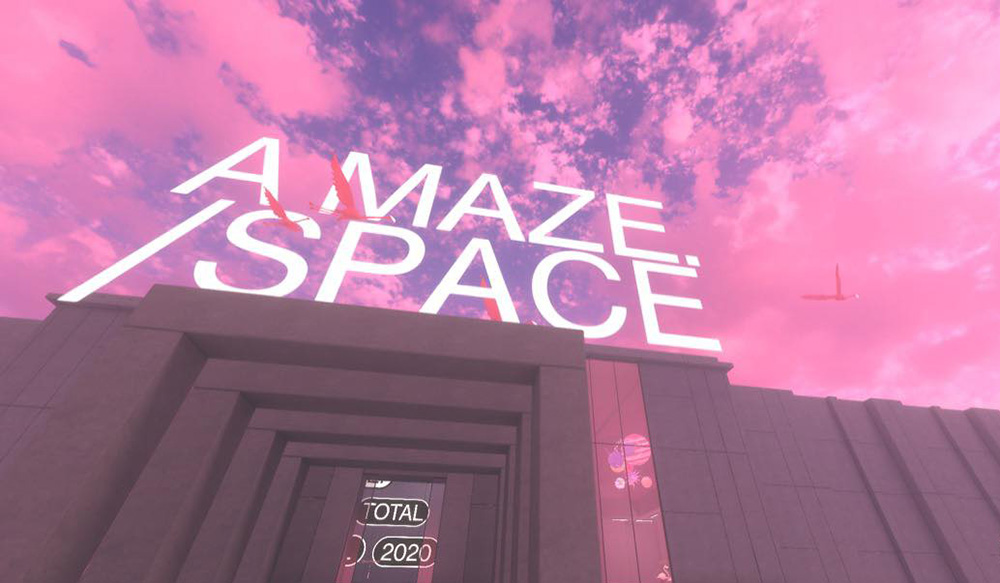
A MAZE. / Berlin 2020, A MAZE. / SPACE
screenshot (2020)
I’ve visited a lot of online exhibitions and gamified conferences this year. They’ve ranged from ‘online viewing rooms’ (glorified photo galleries), to block-by-block recreations of venues in Minecraft, to the surreal and spectacular.
In July, instead of going to Berlin, I make an account to join the online digital experience of A MAZE.—a four-day festival for arthouse games and media. As soon as I enter my details for the virtual experience, I’m dropped at the entrance of a megalith venue, now as a pink flamingo avatar.
I lean closer to take it all in, wanting to pass through the boundary of my screen into a new world. To feel the heat of the day on the pavement as I look up and admire the tropical pink sunset. To smell the gentle brininess from the surrounding shallow sea that stretches out to infinity. To run my hands along the black polished concrete wall and feel tiny pockmarks as I walk inside.
I race through the space in my flamingo body, marvelling at the off-kilter exhibition halls, probing the walls for ‘Easter eggs’ and taking in the panel discussions.
^~^~^~^~^~^~^
Marc Loths created This, Too, Shall Pass in 2019. It’s described as a slow game, with just five physical copies in existence, being shared and passed on around the globe.
On the surface, this art game is about the climate crisis and the feeling of watching nature change and degrade before our eyes. The player walks through a stylised landscape matched to their real-life geographic location, making the experience at once familiar and strange—but always unique to the player.
Slowly, the barren terrain sprouts greenery, ranging from ancient redwoods to lush cherry blossoms to hardy shrubs. Weather patterns emerge and gargantuan, grotesque, seemingly alien- or man-made structures appear.
One could extrapolate a narrative about the settler-colonial destruction of Earth. Poetic text intermittently appears on screen, with cryptic messages like, It will take many lifetimes to cease mourning what we have lost.
But there’s no clear goal to achieve in this ephemeral, fluid landscape. Instead, This, Too, Shall Pass is a walking simulator without any gamified feedback. Simply existing is thrilling enough. Explore for a little while, then pass your game copy on to someone new, knowing they may never see the same horizon you did.
^~^~^~^~^~^~^
At 11pm one night I watch a friend play No Man’s Sky on Twitch in what they call a ‘bedtime stream’. Their spaceman avatar lands on a procedurally-generated alien planet and they begin chipping away at infinite resources with a laser gun.
The pulsating whir of the laser gun is somniferous, as their spaceman blasts at an immense bulbous plant to harvest much-needed carbon. The greenish-yellow limbs of the plant shrink down and crumble in an uncanny, un-plant-like way. The laser throbs. Intermittent pings in the live chat signal viewers giving tips on how to optimise gameplay and complete more tasks.
Nah, mate, my friend always says, I just want to walk around and explore.
As I drift off to sleep I imagine I’m sitting on the spaceman’s shoulder whispering new names for the plants we discover. Not because we need to catalogue them, but because we want to remember what we witnessed.
^~^~^~^~^~^~^

Ian MacLarty, Red Desert Render
screenshot (2020)
I’ve been re-watching a talk given by Ian MacLarty and Kalonica Quigley as part of Freeplay Independent Games Festival in June. Part interview, part ‘let’s play’, the hour-long session is called ‘A bushwalk in Red Desert Render‘.
The game—Red Desert Render—was made by Ian and inspired by experiences shared with friends exploring the out-of-bounds areas in the big-budget game Red Dead Redemption 2. Glitching through game worlds into out-of-bounds areas has a deep history, whether as an exploit tool for reaching a goal or revealing mechanics. Now it’s established practice to poke around the inner workings of a game, or, as Kalonica notes, to embark on a kind of spiritual experience for the sake of adventure.
In Red Desert Render, rolling hills and gullies extend away as far as the eye can see (or as far as the computer will render). Ian describes it as the video game equivalent of a landscape painting, but here you can walk beyond the frame and off into the horizon with the world following around you.
The gentle crunch crunch crunch of footsteps through the brush punctuates the conversation.
Kalonica begins, Let’s start walking, Ian. Where do you wanna go? Ian pauses, Oh umm, where do you wanna go?
^~^~^~^~^~^~^
In A MAZE., I stand amongst a crowd of other flamingos in a grand hall and watch a cinema-sized screen where Sisi Jiang, a writer and narrative designer, gives a talk on games without borders. While so many games are about solving a puzzle, getting a goal, or unlocking a secret, Sisi instead explores the possibility of storytelling and narratives that aren’t in service of helping a player crack the code or collect the gems.
It’s a critical look at successes and shortcomings in recent video games, and the conversations we aren’t having about the historical implications of so many popular titles.
The screen within a screen reads:
If you’ve ever seen tea in a Victorian game, you’re observing the colonization of India. If your characters are wearing mass-produced cotton shirts, then American chattel slavery is in your game.
Sisi urges game writers to create and flesh out worlds that help us reflect on and relate to reality. That means responsibly building cultures and economies into non-player character (NPC) conversations—ensuring diversity and an awareness of geopolitics, and immersing players in a vast world that continues beyond the horizons defined by the game.
^~^~^~^~^~^~^
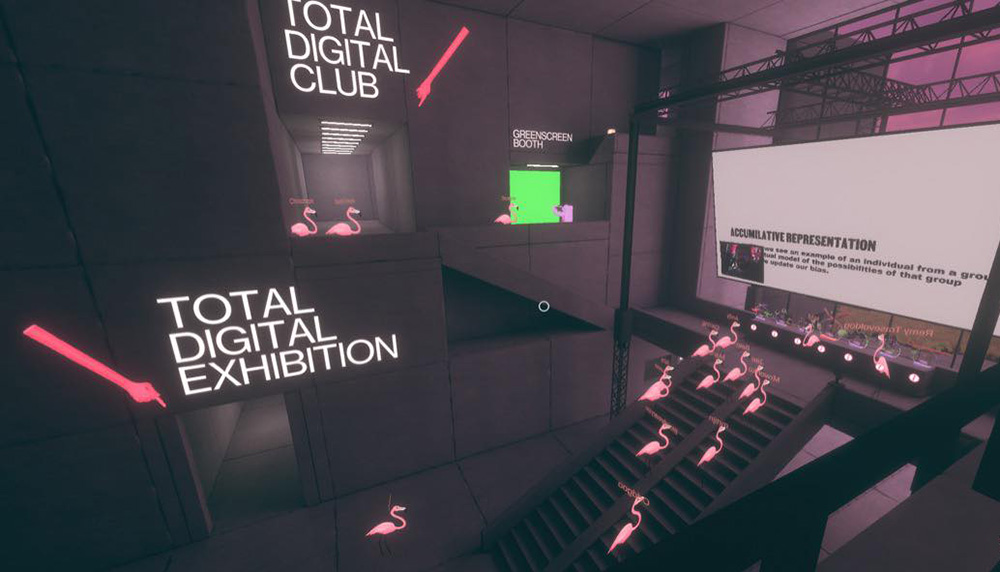
A MAZE. / Berlin 2020, A MAZE. / SPACE
screenshot (2020)
I’m buoyed by the idea that leaving a plant untended may allow something beautiful to flourish. When I leave Animal Crossing for weeks at a time, a patchwork of weeds springs up in unoccupied spaces. I oscillate between wanting to cultivate these weeds and wanting to tackle them like a chore.
Either way, their unending presence somehow soothes. I can measure real-world time by the mechanics of this virtual nature—an ephemeral world quietly existing even when I’m not there, ageing and changing all the same.
Unlike Red Desert Render and No Man’s Sky, which use procedural generation to sprout life as needed in a sphere around the player, Animal Crossing is a fixed landscape. It is contained and controlled, but still flourishes untended. Now, I like to imagine other digital architectures changing over time without me there. That black polished concrete turning mossy and damp.
^~^~^~^~^~^~^
Hugging the dark walls of A MAZE. is like navigating a labyrinth in a timeless vacuum. Every glimpse of the sky through a brutalist window shows the tropical sunset unchanging. I see countless worlds presented to me, stumbling through vast halls and tight corridors. If the objective is attendance, I beat this game without a compass or a beacon or Ariadne’s thread.
It’s in A MAZE. I discover Marc Loth’s This, Too, Shall Pass, and another game called Utopias: Navigating Without Coordinates, by AAA Collective. Utopias is a network of nine separate worlds, each expressing the personal vision of a member of the collective. But it extends beyond open-world philosophies, not just because it contains nine worlds, but because its process-driven creation is perhaps more important than its gameplay. This is an experiment in collaborative world-building against individualism—an approach that, according to their statement, is a real-world and in-game attempt to roleplay our way into utopia.
Watching game trailers, documentaries and panel discussions at A MAZE., I feel overwhelmed by the windows of worlds and screens within screens proposing expansive new futures. I remain a few too many planes of existence removed from where the utopias are on display. The laptop screen, the black concrete venue, my apartment window—all become frames that take on abstract scales and forms, like two-dimensional backdrops I might pierce and pass through on my way to the horizon.
^~^~^~^~^~^~^
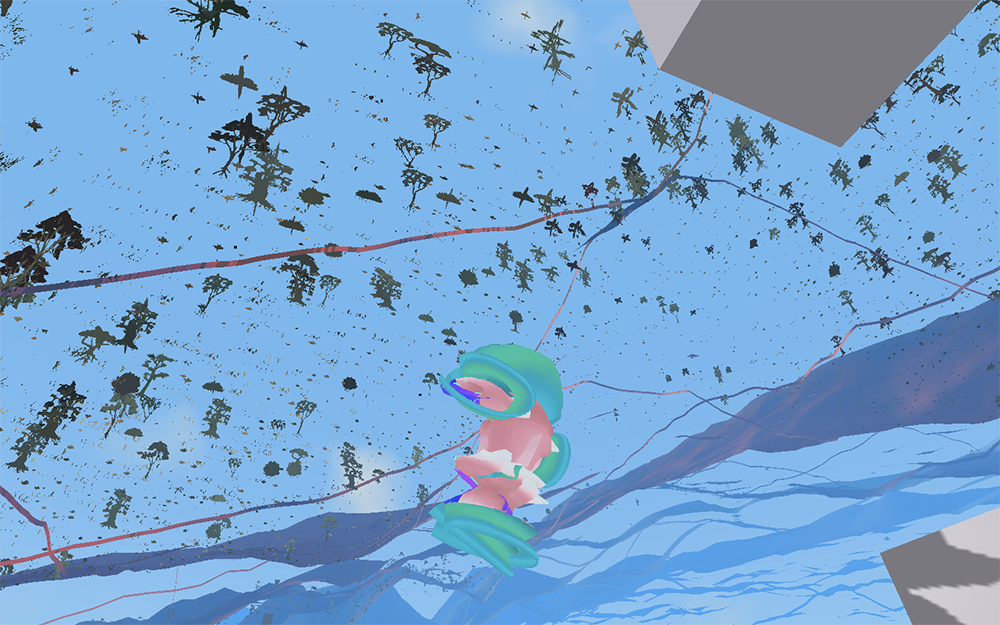
Ian MacLarty, Red Desert Render
screenshot (2020)
Ian talks about the landscape of video games being designed like a theme park. Every few minutes there’s a new NPC to help on a quest, and every great vantage point has been crafted, waiting for a visitor like you.
The facades are created with the conceit that this could all be real, but the walls—visible or invisible—are still pushing you along an inflexible path. If you can manage to get out-of-bounds, you’ll find the horizon is just an illusion, sketched out in broad strokes only.
Ian reflects: the terrain is not designed for you to traverse it, everything is jagged edges, you can sometimes fall through the geometry, you can fall off the end of the world if you get too close to it.
Red Desert Render is a true homage to this experience. Playful interaction points warp the gameplay and white cubes float in the bush, dropping players down through the whole world to an underground ocean.
A commenter types, there’s something so magical about swimming towards the stars.
^~^~^~^~^~^~^
One of the first times I watched Emma play World of Warcraft, we decided to throw her priest over the edge of a waterfall in a place called Teldrassil. We couldn’t make out the bottom of the falls but were excited by the possibility of exploring a new area or transgressing into a dead-end of low-quality textures.
Instead, the priest fell down the waterfall, through the pool at the bottom, and through the world itself. Like many games, the priest began treading water in an infinite underworld ocean. Teldrassil is an ancient tree with a country-sized diameter, inside of which cities have been built. From this vantage point, looking up, we could see this massive structure, with each tendril-like root extending out and dwarfing the priest in the water.
We swam in the empty ocean as the sun descended, painstakingly circumventing the colossal roots until we found a place where the priest could haul himself up the edge of the world, back to safety.
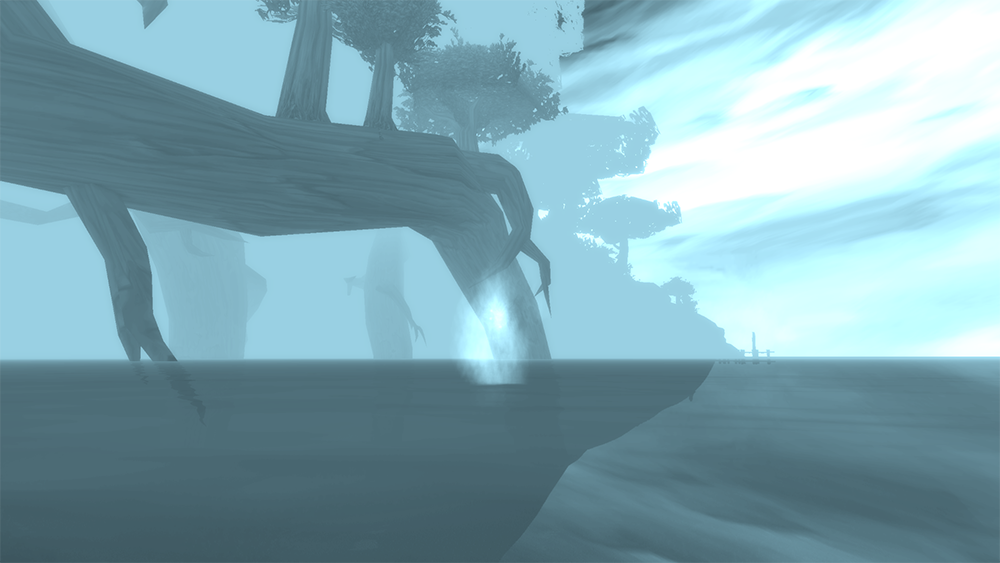
Blizzard Entertainment, World of Warcraft Classic
screenshot (2020)